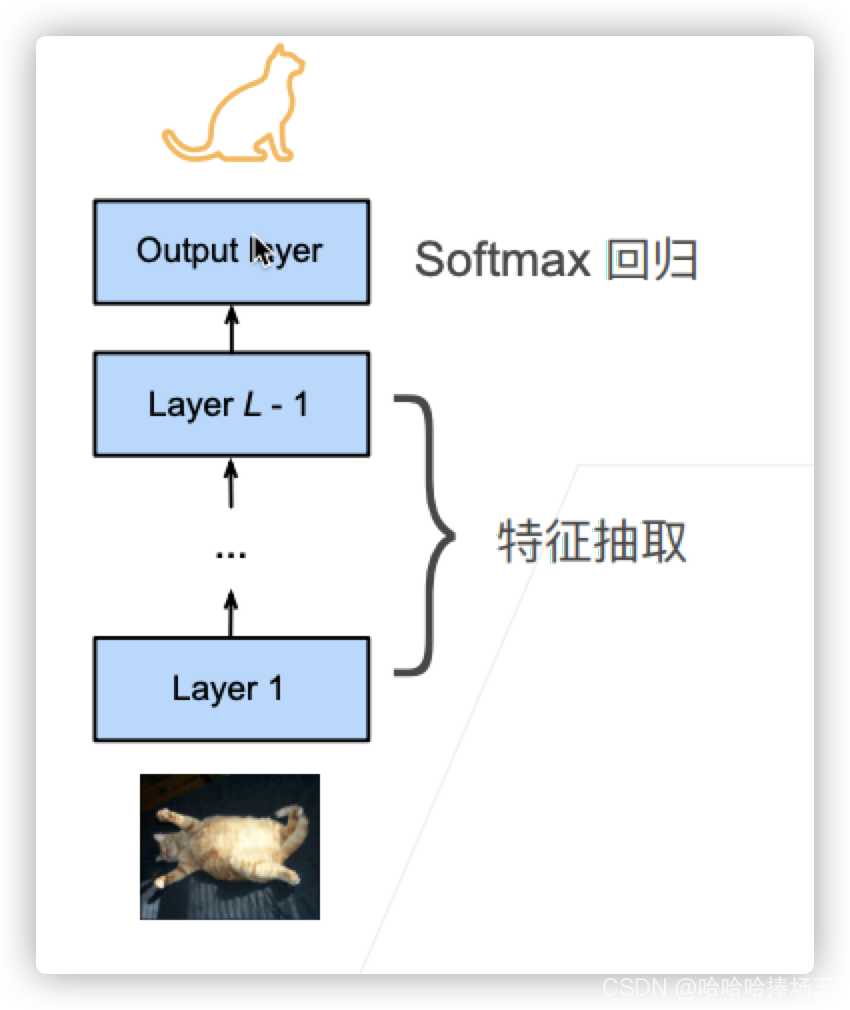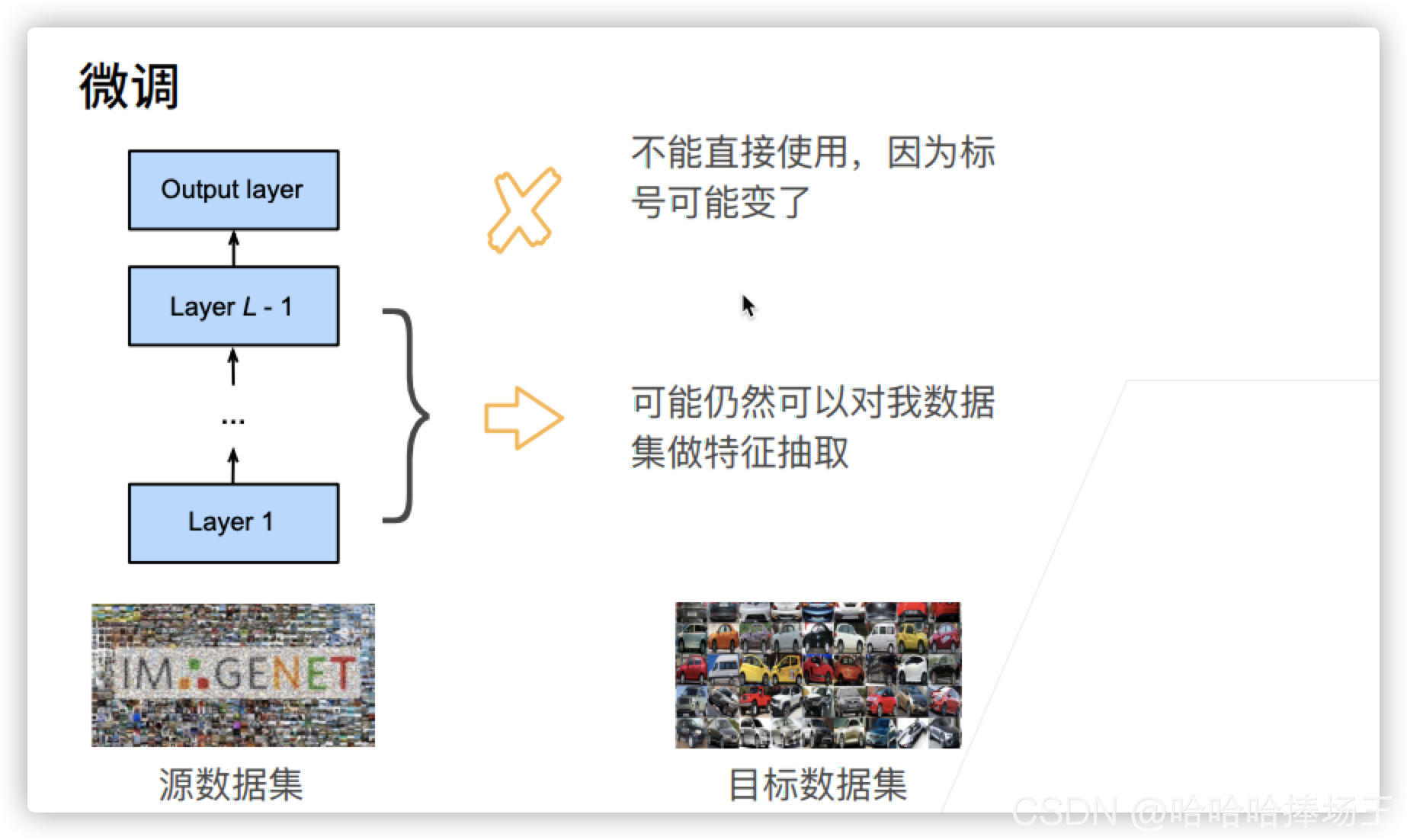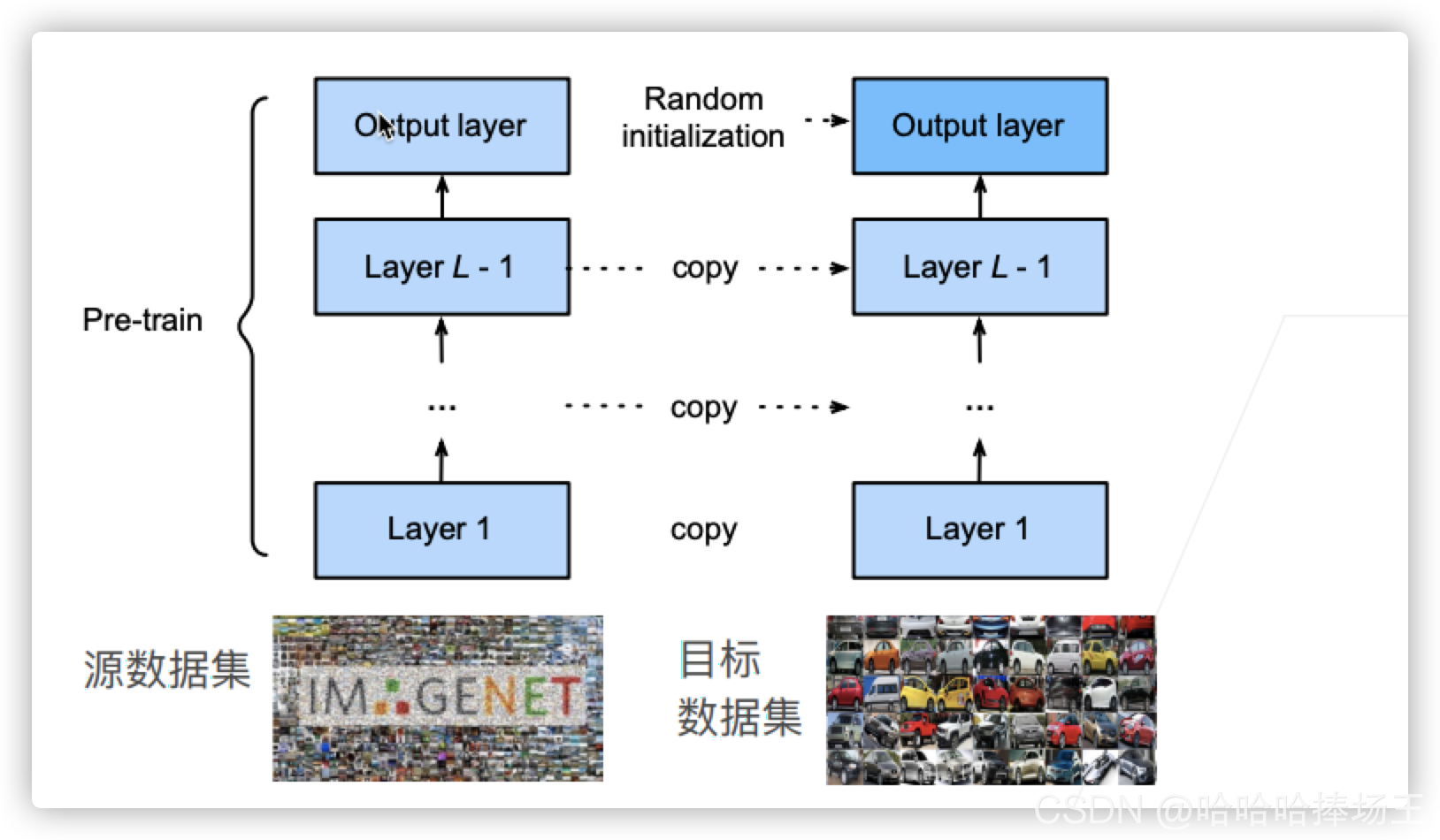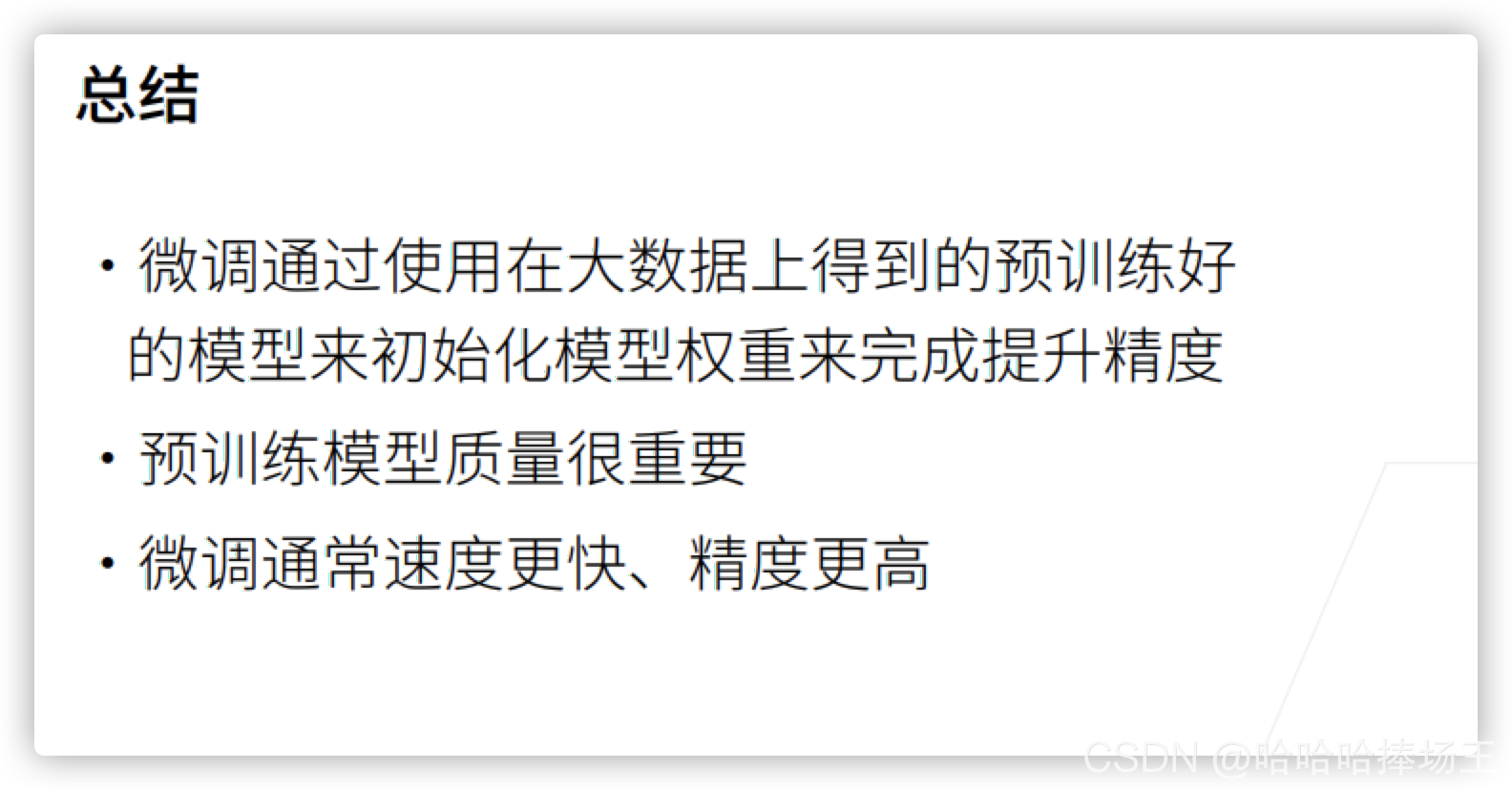微调
- 标注一个数据集很贵
网络架构
- 一个神经网络一般可以分为两块
- 特征抽取将原始像素变成容易线性分割的特征。意思就是将原始的像素变换为很容易分割的线性特征
- 线性分类器来做分类

微调
- 微调的意思就是在源数据集上,已经训练好了一个模型。假设这个模型确实是按照我们想的来进行的(先做特征提取,然后做分类),那么我们可以认为,我们在你的数据集上面可以进行比较的好的特征提取,那么他在我们的数据集上也可以做一个比较好的特征提取。但是分类器我们不能直接使用。

微调中的权重初始化
- 假设我们在源数据集训练好了一个模型,一般称为Pre-train,然后我们在我们自己的模型我们使用与Pre-train一样的架构的模型,我们模型的初始化不再是随机初始化,我们直接将Pre-train好的参数copy过来使用,这样我们这个模型一开始就可以获得一个还可以的效果。当然最后一层可以随机的初始化

训练
- 是一个目标数据集上的正常训练任务,但使用更强的正则化
- 使用更小的学习率
- 使用更少的数据迭代
- 源数据集远复杂于目标数据,通常微调效果更好
重用分类器权重
- 源数据集中可能也有目标数据中的部分标号
- 可以使用预训练好模型分类器中对应标号对应的向量来做初始化
固定一些层
- 神经网络通畅学习有层次的特征表示
- 低层次的特征更加通用
- 高层次的特征则更跟数据集相关
- 可以固定底部一些层的参数,不参与更新
- 更强的正则
总结

代码实现
%matplotlib inline
import os
import torch
import torchvision
from torch import nn
from d2l import torch as d2l
d2l.DATA_HUB['hotdog'] = (d2l.DATA_URL + 'hotdog.zip', 'fba480ffa8aa7e0febbb511d181409f899b9baa5')
data_dir = d2l.download_extract('hotdog')
train_imgs = torchvision.datasets.ImageFolder(os.path.join(data_dir, 'train'))
test_imgs = torchvision.datasets.ImageFolder(os.path.join(data_dir, 'test'))
Downloading ../data/hotdog.zip from http://d2l-data.s3-accelerate.amazonaws.com/hotdog.zip...
# 图像的大小和纵横比各有不同
hotdogs = [train_imgs[i][0] for i in range(8)]
not_hotdogs = [train_imgs[-i - 1][0] for i in range(8)]
d2l.show_images(hotdogs + not_hotdogs, 2, 8, scale=1.4);
[外链图片转存失败,源站可能有防盗链机制,建议将图片保存下来直接上传(img-aQJJ2npC-1629872905362)(output_3_0.png)]
# 数据增广
# 将RGB的通道
normalize = torchvision.transforms.Normalize([0.485, 0.456, 0.406],
[0.229, 0.224, 0.225]) # 这里就是相当于做了一个批量的归一化,如果我们的网络结构中有就不需要这个
train_augs = torchvision.transforms.Compose([
torchvision.transforms.RandomResizedCrop(224),
torchvision.transforms.RandomHorizontalFlip(),
torchvision.transforms.ToTensor(), normalize])
test_augs = torchvision.transforms.Compose([
torchvision.transforms.Resize(256),
torchvision.transforms.CenterCrop(224),
torchvision.transforms.ToTensor(), normalize])
# 定义和初始化模型
pretrained_net = torchvision.models.resnet18(pretrained=True) #这一行代码的意思就是
pretrained_net.fc # fc的意思就是fully connect也就是全连接,也就是最后一层
Downloading: "https://download.pytorch.org/models/resnet18-f37072fd.pth" to /Users/tiger/.cache/torch/hub/checkpoints/resnet18-f37072fd.pth
100.0%
Linear(in_features=512, out_features=1000, bias=True)
finetune_net = torchvision.models.resnet18(pretrained=True) # 这里和前面一样将我们模型下载下来
finetune_net.fc = nn.Linear(finetune_net.fc.in_features, 2) # 这里就是将最后fully connect层随机初始化为一个线性层,input为512,输出为2
nn.init.xavier_normal_(finetune_net.fc.weight); # 这里对上面的fully connect层的参数做了一个随机初始化
# 模型微调
def train_fine_tuning(net, learning_rate, batch_size=128, num_epochs=5,
param_group=True):
train_iter = torch.utils.data.DataLoader(
torchvision.datasets.ImageFolder(os.path.join(data_dir, 'train'),
transform=train_augs),
batch_size=batch_size, shuffle=True)
test_iter = torch.utils.data.DataLoader(
torchvision.datasets.ImageFolder(os.path.join(data_dir, 'test'),
transform=test_augs),
batch_size=batch_size)
devices = d2l.try_all_gpus()
loss = nn.CrossEntropyLoss(reduction="none")
if param_group:
params_1x = [
param for name, param in net.named_parameters()
if name not in ["fc.weight", "fc.bias"]] # 这里将不是最后一层的所有层的参数都都拿出来
trainer = torch.optim.SGD([{
'params': params_1x}, { # 这里表示不是最后一层的参数,学习率使用默认的学习率
'params': net.fc.parameters(), # 最后一层的参数,最后一层的学习率使用的是10倍
'lr': learning_rate * 10}], lr=learning_rate,
weight_decay=0.001)
else:
trainer = torch.optim.SGD(net.parameters(), lr=learning_rate,
weight_decay=0.001)
d2l.train_ch13(net, train_iter, test_iter, loss, trainer, num_epochs,
devices)
# 使用较小的学习率
train_fine_tuning(finetune_net, 5e-5) # finetune_net就是我们之前定义的最后一层是随机的,其他的层都是我们copy的参数
# 不用pretrain
scratch_net = torchvision.models.resnet18() # 这里就是将模型结构拷贝过来,所有的参数都是随机初始化的
scratch_net.fc = nn.Linear(scratch_net.fc.in_features, 2)
train_fine_tuning(scratch_net, 5e-4, param_group=False)